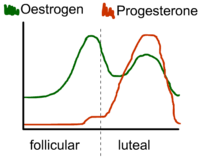Menstrual cycle
Follicular Stage
Due to rising FSH levels at the beginning of the menstrual cycle, follicles become stimulated (hence the name), and 10-25 finish the first stage of meiosis. The theca cells, stimulated by LH begin to produce androgens, which move to the granulosa cells to be turned into oestrogen under the influence of FSH.
One follicle becomes dominant (read oogenesis), and begins to release lots of oestrogen. At low levels this inhibits FSH release, which is why the granulosa cells in the dominant follicle have to be able to respond to LH also. However, as oestrogen levels get higher, the LH surges.
This makes the granulosa cells release progesterone, and less oestrogen, so oestrogen starts to fall, and progesterone begins to rise, as shown on the graph just before ovulation.
The effect of the LH on the granulosa cells is to cause break down of the wall of the follicle, releasing the ovum into the free space of the ovary. This moment is called ovulation, and happens around day 14 of the 28 day menstrual cycle (dotted line on the graphs).
Luteal Stage
The LH surge doesn’t just cause the granulosa cells to break down the follicle wall, it also sets of them and the theca cells forming the corpus luteum. The low levels of LH for the next 14 days are just enough to keep the corpus luteum alive. While its alive it produces loads of progesterone, a fair amount of oestrogen and inhibin.
In the presence of oestrogen, progesterone causes a drop in GnRH levels, leading to the drop off in LH and FSH. Without these gonadotrophins, the corpus luteum only survives two weeks; then it dies, leading to the drop in oestrogen and progesterone at the end of the luteal phase. Without these two, GnRH is no longer inhibited, so LH and FSH pick up again – taking us back to the beginning of the follicular stage!!! Woo! See how it’s a cycle.
Uterine Changes
Right at the beginning of the follicular stage, menstruation is occurring – bleeding from the vagina, as the endometrial lining degenerates.
It soon begins to thicken again, once bleeding stops, as oestrogen builds it up. It thickens and grows until ovulation, when progesterone from the corpus luteum joins the oestrogen.
This makes it juicier, with more secretory glands, and more blood vessels. It gets thicker and thicker, perfect for implantation of an embryo. Prostaglandins produced by the endometrium stimulates uterine contractions; progesterone also inhibits these. When the fall in GnRH drops LH levels, killing the corpus luteum, the resultant drop in prog and oest leads to rapid degeneration of the menstrual lining, so the bleeding start and it happens ‘’all over again…’’
Cervical Mucus
Same thing as with the endometrium. Oestrogen makes the mucus secreted by the cervix abundant, thin and watery. Progesterone makes it thicker – forming a ‘plug’, which prevents bacteria entering the uterus in case conception has occurred.
Clinical Conditions
Dysmenorrhoea
Prostaglandins produced by the endometrium stimulate these contractions, and overproduction of them is the main cause of dysmenorrhoea, which leads to excess contractions, and can cause contractions in other muscle, causing headaches, nausea, vomiting, etc.

